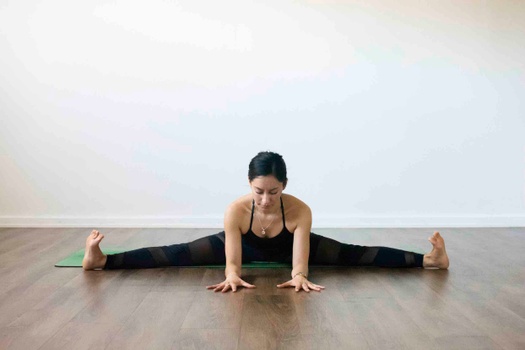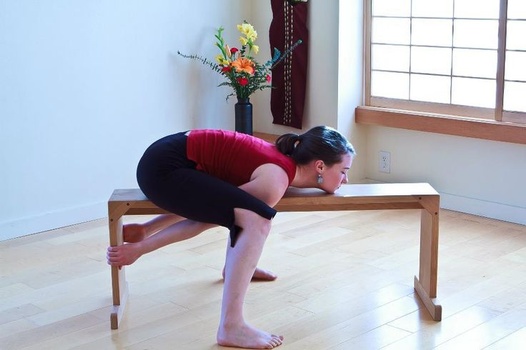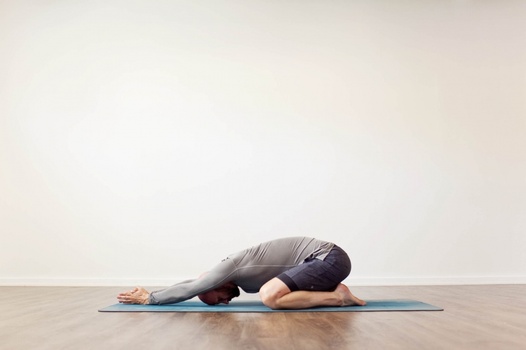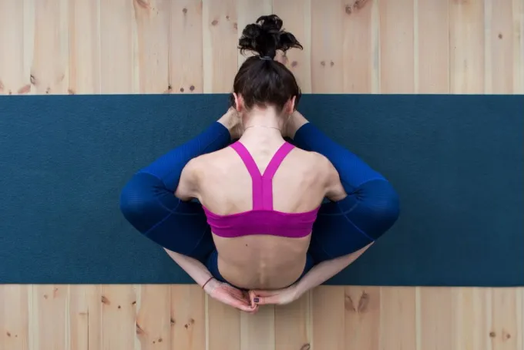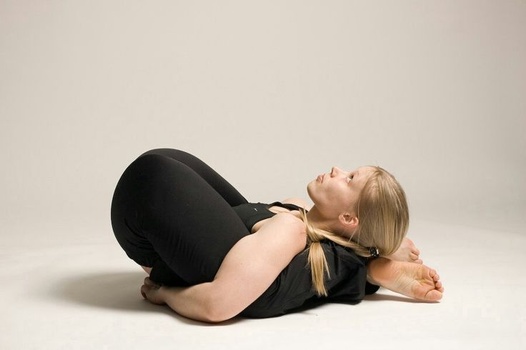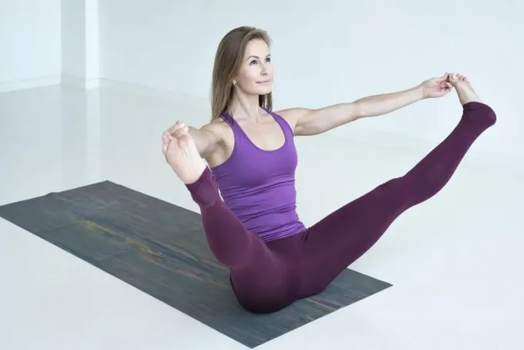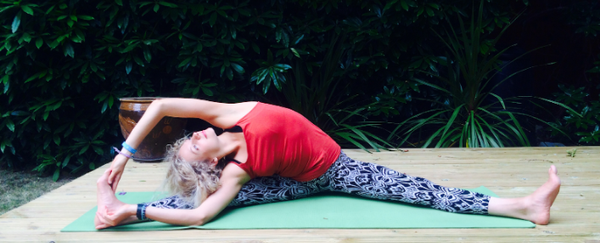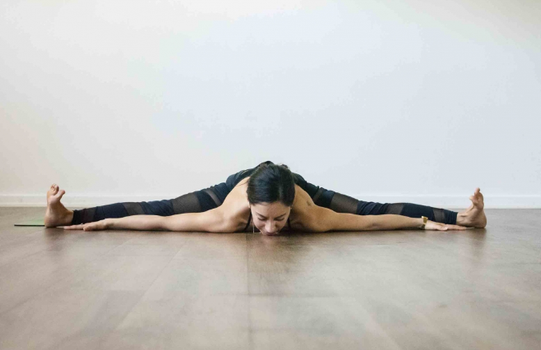We have divided the Kurmasana practice into a few different phases to help you get started in your practice.
Part 1 - Preparatory Poses for Kurmasana
Tortoise pose is an advanced yoga posture that requires activation of your full body. Here are some warm-up poses to help you get ready:
1. Uttanasana (Standing Forward Bend) - Start with Mountain pose. Take a few breaths here to stabilize your core and lengthen your spine. Inhale as you stand with your feet hip-width apart and place your hands at the side of your waist.
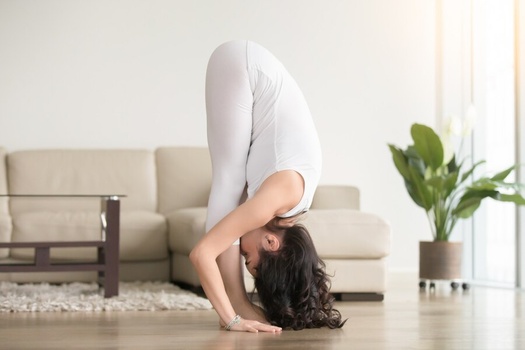
Exhale and start to hinge your upper body forward. Stretch your arms overhead and let them touch the ground. Hold this position until your glutes and hamstrings feel activated, and your spine, arms, and shoulders feel more flexible and relaxed.
2. Upavistha Konasana (Wide-Angle Seated Forward Bend) - Sit on your mat and spread your legs wide on each side. Inhale, flex your arms overhead for a few seconds to activate your whole upper body.
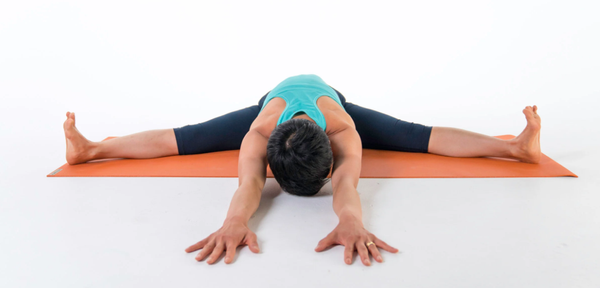
Exhale and start to bend forward toward the ground. Rest your palms, forehead, chest, and core on the floor completely. Hold this pose for 2-3 minutes to get your spine, glutes, and shoulders stimulated with blood circulation.
3. Garudasana (Eagle Pose) - Start by standing on one leg. Cross your right knee over your left kneecap, and bend your left leg. If your flexibility allows, then wrap your left foot behind your right calf muscle, creating a complete eagle legs formation.
Keep your glutes in a neutral position, and elongate your spine by lifting your chest up.
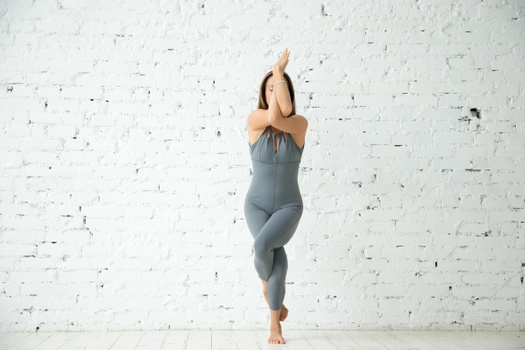
Next, bring your right arm over your left and cross your elbows. Bring the palms of both your arms together to clasp each other tightly and form the eagle arms formation.
Keep your elbows at your shoulder level and hold this pose as long as it feels comfortable. Release and repeat on the other side. This is a great way to activate flexibility and strength in your limbs and core.
Part 2: Step-by-Step Instructions to Perform Kurmasana
The following are steps to practice Tortoise or Turtle pose:
Step 1- Start from a seated position. Bend and spread your legs out at the sides, so each leg makes a triangle with the ground.
Step 2- Bring your torso forward and close to the ground by bending from your low back. Don't rest your head entirely on the floor. Stay close to the ground for a few seconds.
Step 3- Bring your chest forward, roll your shoulders, and thread each arm under your legs at your sides. Scooch your arms slowly under your legs so that your shoulders are right below your knees.
Step 4- Breathe and hold this semi-tortoise pose for a few seconds. Withdraw all of your senses, exhale and then gently lower your legs, arms, chest, and forehead completely to the ground.
Step 5- Take deep breaths and focus on the stretch you feel in your whole body.
Step 6- Count 5 to 10 deep breaths and then slowly release the pose. Bend your legs slightly, release your arms from below your legs, and relax in Seated Forward Bend pose.
Breath Awareness:
Inhale: While sitting with your legs spread wide.
Exhale: When your torso is bending forward toward the ground
Inhale & Exhale: While holding the position for a few seconds.
Performance Duration for Beginners: Hold Kurmasana for 5 to 6 deep breaths.
Performance Duration for Advanced: Hold Kurmasana for 5 to 10 deep breaths or as long as it feels comfortable.
Part 3: Things to Keep in Mind
The Tortoise pose practice requires a lot of awareness among all of your senses. Misalignment can lead to negative after-effects, so here are a few posture cures to keep in mind while performing Kurmasana:
Avoid straining your knees: Your feet should be flexed, but do not lock your knee joints to achieve this. Locking your knee joints while strengthening your legs can put unnecessary pressure on your knee joints. This can lead to severe injury or even damage to your knees. To prevent this, maintain a soft bend in your knees and bring your legs straight to the ground very slowly.
Release slowly: Since your spine, neck, and shoulders are in a very compromised position, it’s important to be mindful of your technique while releasing this pose. Releasing too quickly can increase your chance of injury, so focus on your breathing and release the pose very gently.
Part 4: Relaxing Poses After Kurmasana
Here are a few counter yoga poses you can perform after your Tortoise pose practice for faster recovery and a healthy spine.
1. Halasana (Plough Pose): Lie on your back with your legs and feet together and palms facing down on either side. Press down with your hands on the mat, lift your legs up, and then over your head. Ensure that your toes touch the floor. You can also put your hands on your low back to stabilize your core.
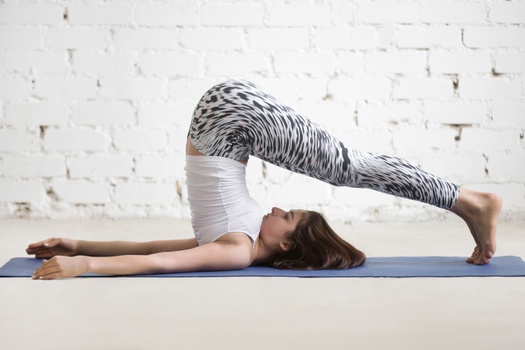
Breathe here in this position for a few seconds. Finally, exhale as you press your palms again into the ground to unroll your spine back on the mat. Lie in Corpse pose for a few seconds until your whole body relaxes. This will allow your lower back, shoulders, traps, and neck to rest.
2. Ananda Balasana (Happy Baby Pose): Continue from Corpse position. Lie on your back, ensuring that there is no gap in between your tailbone and the ground. Lift your legs up, making a 90-degree angle with the ground. Bend your legs, and grab the outer edges of both of your feet on each side.
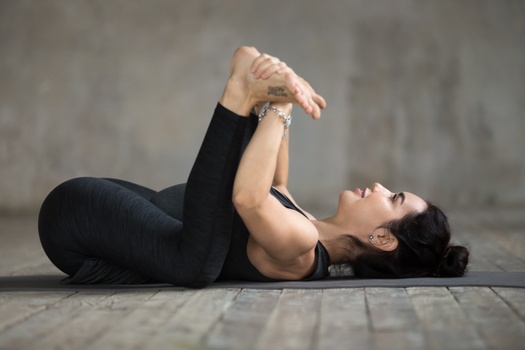
Now, push down toward the floor, so your knees are aligned with your armpits. Hold this pose until you feel relaxed in your spine and lower back. You can also gently rock from side to side, making it a super Happy Baby pose for faster recovery.










